Linear Elasticity Fracture Mechanics#
Authors:
Laura De Lorenzis (ETH Zürich)
Veronique Lazarus (ENSTA, IPP)
Corrado Maurini (Sorbonne Université, corrado.maurini@sorbonne-universite.fr)
This notebook serves as a tutorial for linear elastic fracture mechanics
import sys
sys.path.append("../utils")
# Import required libraries
import matplotlib.pyplot as plt
import numpy as np
import dolfinx.fem as fem
import dolfinx.mesh as mesh
import dolfinx.io as io
import dolfinx.plot as plot
import dolfinx.fem.petsc
import ufl
from mpi4py import MPI
from petsc4py import PETSc
from petsc4py.PETSc import ScalarType
plt.rcParams["figure.figsize"] = (6,3)
outdir = "output"
from pathlib import Path
Path(outdir).mkdir(parents=True, exist_ok=True)
Asymptotic field and SIF (\(K_I\))#
Let us first get the elastic solution for a given crack length
sys.path.append("../../utils")
from elastic_solver import solve_elasticity
Lx = 1.
Ly = 0.5
Lcrack = 0.3
lc =.05
dist_min = .1
dist_max = .3
uh, energy, sigma_ufl = solve_elasticity(Lx=Lx,
Ly=Ly,
Lcrack=Lcrack,
lc=lc,
refinement_ratio=20,
dist_min=dist_min,
dist_max=dist_max,
verbosity=1)
from plots import warp_plot_2d
import pyvista
try:
pyvista.start_xvfb()
except:
pyvista.set_jupyter_backend("static")
import ufl
sigma_iso = 1./3*ufl.tr(sigma_ufl)*ufl.Identity(len(uh))
sigma_dev = sigma_ufl - sigma_iso
von_Mises = ufl.sqrt(3./2*ufl.inner(sigma_dev, sigma_dev))
V_dg = fem.functionspace(uh.function_space.mesh, ("DG", 0))
stress_expr = fem.Expression(von_Mises, V_dg.element.interpolation_points())
vm_stress = fem.Function(V_dg)
vm_stress.interpolate(stress_expr)
plotter = warp_plot_2d(uh,cell_field=vm_stress,field_name="Von Mises stress", factor=.1,show_edges=True,clim=[0.0, 1.0],show_scalar_bar=True)
if not pyvista.OFF_SCREEN:
plotter.show()
else:
figure = plotter.screenshot(f"{outdir}/VonMises.png")
The potential energy for Lcrack=3.000e-01 is -4.114e-01
error: XDG_RUNTIME_DIR is invalid or not set in the environment.
MESA: error: ZINK: failed to choose pdev
glx: failed to create drisw screen
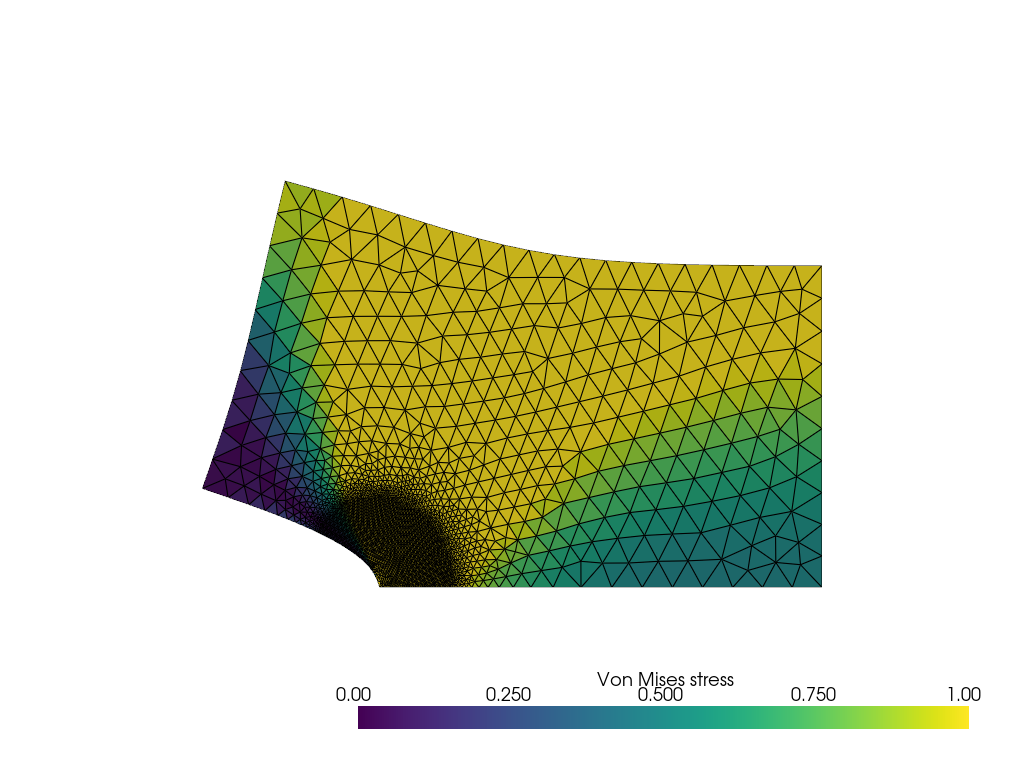
Crack opening displacement (COD)#
Let us get the vertical displacement at the crack lip
from evaluate_at_points import evaluate_at_points
xs = np.linspace(0,Lcrack * 1.2 ,100)
ys = 0.0 * np.ones_like(xs)
zs = 0.0 * np.ones_like(xs)
points = np.array([xs,ys,zs])
u_values = evaluate_at_points(points,uh)
us = u_values[:,1]
plt.plot(xs,us,".")
plt.xlim([0.,Lcrack *1.2])
plt.xlabel("x - coordinate")
plt.ylabel(r"$u_y$")
plt.title("Crack opening displacement")
plt.savefig(f"{outdir}/COD.png")
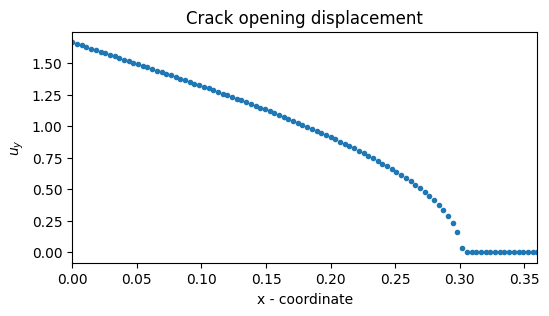
As detailed in the lectures notes, we can estimate the value of the stress intensity factor \(K_I\) by extrapolating \(u \sqrt{2\pi/ r}\)
r = (Lcrack-xs)
#r_ = r[np.where(xs<Lcrack)]
#us_ = us[np.where(xs<Lcrack)]
nu = 0.3
E = 1.0
mu = E / (2.0 * (1.0 + nu))
kappa = (3 - nu) / (1 + nu)
factor = 2 * mu / (kappa + 1)
plt.semilogx(r,us * np.sqrt(2*np.pi/r)*factor,".")
plt.xlabel("r")
plt.ylabel(r"${u_y} \,\frac{2\mu}{k+1} \,\sqrt{2\pi/r}$")
plt.title("Crack opening displacement")
plt.savefig(f"{outdir}/KI-COD.png")
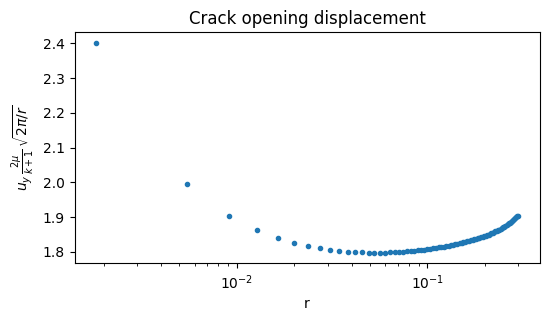
We estimate \(K_I\simeq 1.8\pm0.1\)
Stress at the crack tip#
Let us get the stress around the crack tip
xs = np.linspace(Lcrack,2*Lcrack,1000)
ys = 0.0 * np.ones_like(xs)
zs = 0.0 * np.ones_like(xs)
points = np.array([xs,ys,zs])
r = (xs-Lcrack)
sigma_xx_expr = fem.Expression(sigma_ufl[0,0], V_dg.element.interpolation_points())
sigma_xx = fem.Function(V_dg)
sigma_xx.interpolate(sigma_xx_expr)
sigma_xx_values = evaluate_at_points(points,sigma_xx)
plt.plot(r,sigma_xx_values[:,0],"o")
plt.xlabel("r")
plt.ylabel(r"$\sigma_{rr}$")
plt.title("Stress at the crack tip")
plt.savefig(f"{outdir}/stress.png")
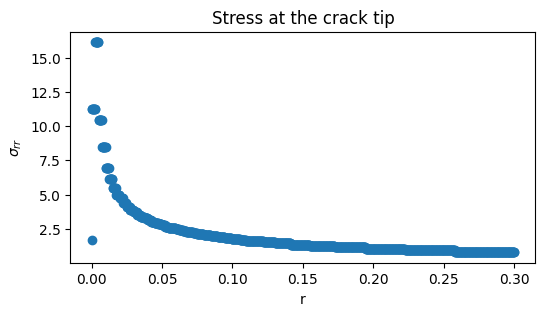
As detailed in the lectures notes, we can estimate the value of the stress intensity factor \(K_I\) by extrapolating \(\sigma_{rr} \sqrt{2\pi r}\)
plt.semilogx(r,sigma_xx_values[:,0]*np.sqrt(2*np.pi*r),"o")
plt.xlabel("r")
plt.ylabel(r"$\sigma_{rr}*\sqrt{2\pi\,r}$")
plt.title("Stress at the crack tip")
plt.savefig(f"{outdir}/KI-stress.png")
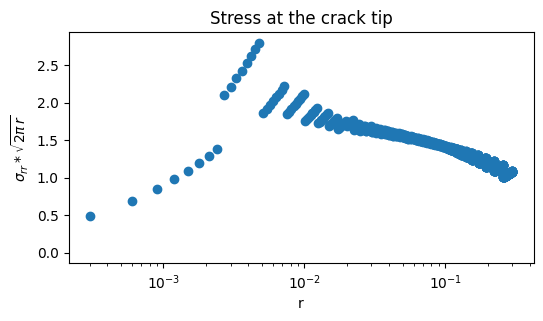
We can say that \(K_I\simeq 1.5\pm .5\) as from the COD, but this estimate is not precise and reliable.
From Irwin’s formula in plane-stress, we get the energy release rate (ERR)
KI_estimate = 1.8
G_estimate = KI_estimate ** 2 / E # Irwin's formula in plane stress
print(f"ERR estimate is {G_estimate}")
ERR estimate is 3.24
The elastic energy release rate#
Naïf method: finite difference of the potential energy#
Let us first calculate the potential energy for several crack lengths. We multiply the result by `2`` to account for the symmetry when comparing with the \(K_I\) estimate above.
Ls = np.linspace(Lcrack*.7,Lcrack*1.3,10)
energies = np.zeros_like(Ls)
Gs = np.zeros_like(Ls)
for (i, L) in enumerate(Ls):
uh, energies[i], _ = solve_elasticity(Lx=Lx,
Ly=Ly,
Lcrack=L,
lc=.05,
refinement_ratio=10,
dist_min=.1,
dist_max=1.,
verbosity=1)
energies = energies * 2
The potential energy for Lcrack=2.100e-01 is -3.138e-01
The potential energy for Lcrack=2.300e-01 is -3.305e-01
The potential energy for Lcrack=2.500e-01 is -3.501e-01
The potential energy for Lcrack=2.700e-01 is -3.731e-01
The potential energy for Lcrack=2.900e-01 is -3.998e-01
The potential energy for Lcrack=3.100e-01 is -4.305e-01
The potential energy for Lcrack=3.300e-01 is -4.660e-01
The potential energy for Lcrack=3.500e-01 is -5.061e-01
The potential energy for Lcrack=3.700e-01 is -5.521e-01
The potential energy for Lcrack=3.900e-01 is -6.035e-01
We can estimate the ERR by taking the finite-difference approximation of the derivative
ERR_naif = -np.diff(energies)/np.diff(Ls)
plt.figure()
plt.plot(Ls, energies,"*")
plt.xlabel("L_crack")
plt.ylabel("Potential energy")
plt.figure()
plt.plot(Ls[0:-1], ERR_naif,"-")
plt.ylabel("ERR")
plt.xlabel("L_crack")
plt.axhline(G_estimate,linestyle='--',color="gray")
plt.axvline(Lcrack,linestyle='--',color="gray")
<matplotlib.lines.Line2D at 0x7feabc165430>
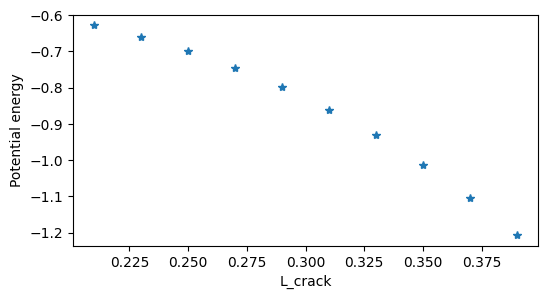
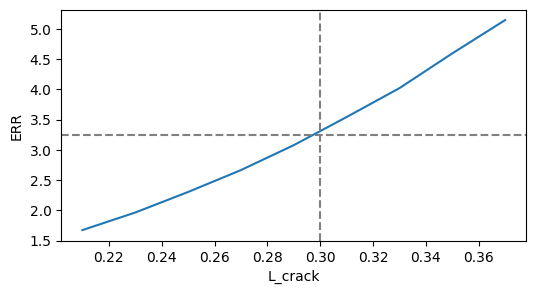
G-theta method: domain derivative#
This function implement the G-theta method to compte the ERR as described in the lecture notes (see newfrac/CORE-school/newfrac-core-numerics/-/blob/master/Core_School_numerical_NOTES.pdf?ref_type=heads).
We first create by an auxiliary computation a suitable theta-field.
To this end, we solve an auxiliary problem for finding a \(\theta\)-field which is equal to \(1\) in a disk around the crack tip and vanishing on the boundary. This field defines the “direction” for the domain derivative, which should change the crack length, but not the outer boundary.
Here we determine the \(\theta\) field by solving the following problem
This is implemented in the function below
def create_theta_field(domain,crack_tip,R_int,R_ext):
def tip_distance(x):
return np.sqrt((x[0]-crack_tip[0])**2 + (x[1]-crack_tip[1])**2)
V_theta = fem.functionspace(domain,("Lagrange",1))
# Define variational problem to define the theta-field.
# We solve a simple laplacian
theta, theta_ = ufl.TrialFunction(V_theta), ufl.TestFunction(V_theta)
a = ufl.dot(ufl.grad(theta), ufl.grad(theta_)) * ufl.dx
L = fem.Constant(domain,ScalarType(0.)) * theta_ * ufl.dx(domain=domain)
# Set the BCs
# Imposing 1 in the inner circle and zero in the outer circle
dofs_inner = fem.locate_dofs_geometrical(V_theta,lambda x : tip_distance(x) < R_int)
dofs_out = fem.locate_dofs_geometrical(V_theta,lambda x : tip_distance(x) > R_ext)
bc_inner = fem.dirichletbc(ScalarType(1.),dofs_inner,V_theta)
bc_out = fem.dirichletbc(ScalarType(0.),dofs_out,V_theta)
bcs = [bc_out, bc_inner]
# solve the problem
problem = fem.petsc.LinearProblem(a, L, bcs=bcs, petsc_options={"ksp_type": "gmres", "pc_type": "gamg"})
thetah = problem.solve()
return thetah
crack_tip = np.array([Lcrack,0])
crack_tangent = np.array([1,0])
crack_tip = np.array([Lcrack,0])
R_int = Lcrack/4.
R_ext = Lcrack
domain = uh.function_space.mesh
thetah = create_theta_field(domain,crack_tip,R_int,R_ext)
# Plot theta
topology, cell_types, geometry = plot.vtk_mesh(thetah.function_space)
grid = pyvista.UnstructuredGrid(topology, cell_types, geometry)
grid.point_data["theta"] = thetah.x.array.real
grid.set_active_scalars("theta")
plotter = pyvista.Plotter()
plotter.add_mesh(grid, show_edges=False)
plotter.add_title("theta-field")
plotter.view_xy()
if not pyvista.OFF_SCREEN:
plotter.show()
error: XDG_RUNTIME_DIR is invalid or not set in the environment.
MESA: error: ZINK: failed to choose pdev
glx: failed to create drisw screen
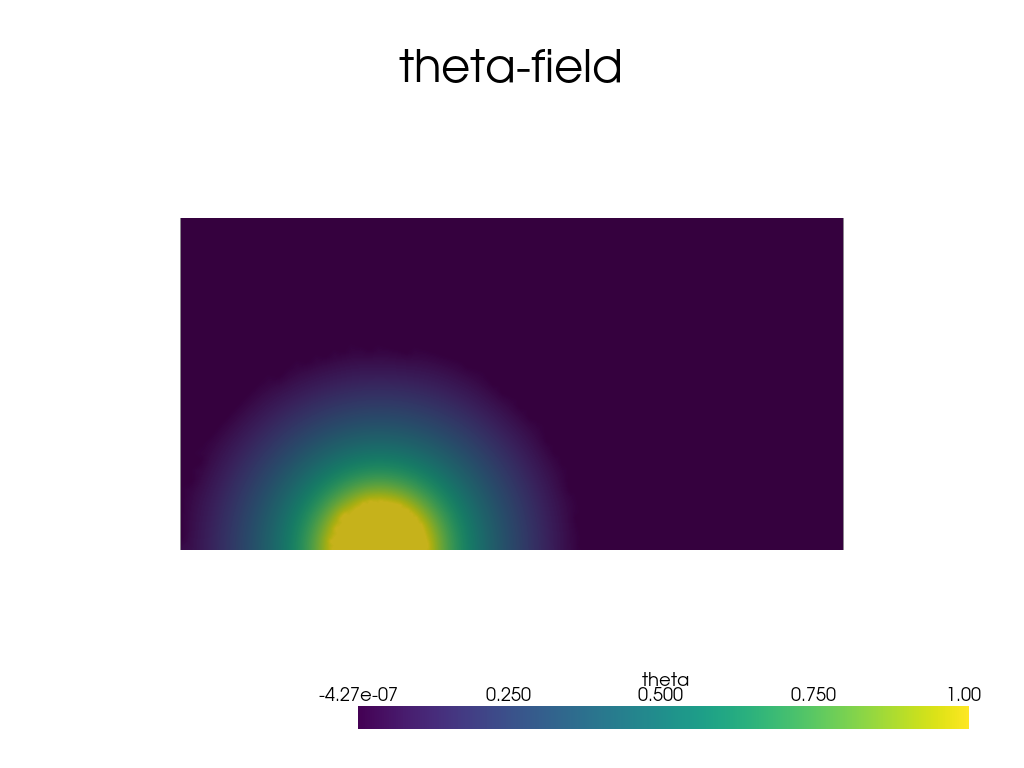
From the scalar field, we define a vector field by multiplying by the tangent vector to the crack: t=[1,0]
Hence, we can compute the ERR with the formula $\( G = \int_\Omega \left(\sigma(\varepsilon(u))\cdot(\nabla u\nabla\theta)-\dfrac{1}{2}\sigma(\varepsilon(u))\cdot \varepsilon(u) \mathrm{div}(\theta)\,\right)\mathrm{dx}\)$
Lx = 1.
Ly = 0.5
Lcrack = 0.3
crack_tip = np.array([Lcrack,0])
crack_tangent = np.array([1,0])
crack_tip = np.array([Lcrack,0])
R_int = Lcrack/4
R_ext = Lcrack
uh, energy, sigma_ufl = solve_elasticity(Lx=Lx,Ly=Ly,Lcrack=Lcrack,lc=.05,refinement_ratio=30,dist_min=.1,dist_max=1.0)
thetah = create_theta_field(uh.function_space.mesh,crack_tip,R_int,R_ext)
eps_ufl = ufl.sym(ufl.grad(uh))
theta_vector = ufl.as_vector([1.,0.]) * thetah
dx = ufl.dx(domain=uh.function_space.mesh)
first_term = ufl.inner(sigma_ufl,ufl.grad(uh) * ufl.grad(theta_vector)) * dx
second_term = - 0.5 * ufl.inner(sigma_ufl,eps_ufl) * ufl.div(theta_vector) * dx
G_theta = 2 * fem.assemble_scalar(fem.form(first_term + second_term))
print(f'The ERR computed with the G-theta method is {G_theta:2.4f}' )
Info : Meshing 1D...
Info : [ 0%] Meshing curve 1 (Line)
Info : [ 30%] Meshing curve 2 (Line)
Info : [ 50%] Meshing curve 3 (Line)
Info : [ 70%] Meshing curve 4 (Line)
Info : [ 90%] Meshing curve 5 (Line)
Info : Done meshing 1D (Wall 0.011202s, CPU 0.011693s)
Info : Meshing 2D...
Info : Meshing surface 1 (Plane, Frontal-Delaunay)
Info : Done meshing 2D (Wall 0.303073s, CPU 0.303743s)
Info : 13070 nodes 26143 elements
The potential energy for Lcrack=3.000e-01 is -4.112e-01
The ERR computed with the G-theta method is 3.0315
Note:
The \(\theta\) field represents how the domain is “varied” to take the domain derivative. It must be 1 on the tip and zero on the boundary of the domain. The choice of the field is otherwise arbritrary. With the generation method above, given the crack length Lcrack, the disk radius Rext should be chosen such that the disk does not intersect the boundary of the domain: Rext < Lcrack. The internal radius Rint can be chosen as few time the mesh size at the tip, for example.



